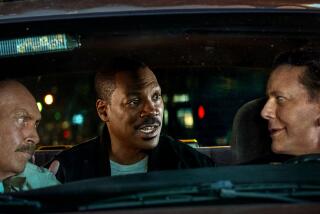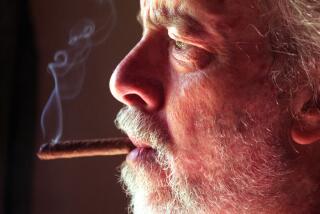Kiefer’s higher ground
Humanity’s puniness amid epic and inevitable collapse has been a theme in Anselm Kiefer’s art for more than 30 years. When he’s at his best, the German artist brings despair to an operatic crescendo. To witness it now, a visit to First Baptist Church of Los Angeles is in order.
Kiefer, 63, has installed a monumental palm tree and three dozen steel-and-glass reliquary tablets in the auditorium-gym of the church, an enormous Spanish Gothic edifice built in 1927. “Palmsonntag (Palm Sunday),” first shown as part of a large installation at Paris’ Grand Palais last year, is an adjunct to an exhibition at Gagosian Gallery in Beverly Hills. (The gallery show is on view through April 26, the church installation through April 27.) The room was reconfigured to accommodate the work. Floors were sanded to remove the basketball court’s markings, and the wall for the reliquary paintings was constructed inside the space.
The 60-foot-long tree, cast in three sections from fiberglass resin and caked with clay on the tangled root ball, lies in state like a consecrated body at a wake. Linen shades cover the room’s high, east-facing windows, filtering the intense California sunshine and giving it the soft, golden brown hue of the surrounding walls.
Opposite those windows, three rows of 12 vitrine paintings fill a wall. Employing a familiar Kiefer lexicon, the vitrines encase dried mangroves, sunflower pods and palm fronds, many slathered in white plaster and mounted on mud-splashed russet panels.
Several panels incorporate small wooden ladders, usually broken or in ruins, one entangled with cascading black hair. The Book of Genesis says that Jacob, taking a stone, “put it under his head and lay down in that place to sleep. And he dreamed that there was a ladder set up on the earth, and the top of it reached to heaven. . . .” As a description, it evokes Kiefer’s palm tree, prostrate in the center of the hall, its sensuously splayed and wilted crown of fronds resting atop a crude pedestal of mud bricks.
Latin legends are scrawled across several tablets. So are the words “Palm Sunday,” written with white chalk in German, French, Polish and other languages. A few extol the Virgin Mary, and these particular reliquaries contain rusted chastity belts. Like the palm branches encased in plaster, a symbol of triumph merges with a sense of false, failed or coerced belief. The installation is a powerful lament for the dead.
Resurrection hovers in the disconsolate atmosphere -- not as specific religious doctrine, whether Christian, Islamic, Buddhist or otherwise, but as spiritual rebirth performed in the mournful tones of lyric elegy. After all, Kiefer’s palm tree is artificial. Making it was surely a monumental headache and a laborious technical struggle. A man-made double haunting its natural counterpart, the sculpture asserts for art a redemptive function that was long ago disrupted by Modernism and its radical doubts.
“Palmsonntag” shares this conflicted condition with Charles Ray’s “Hinoki,” a rotted, 32-foot-long oak log lovingly re-crafted in scores of interlocking blocks of enduring, laminated cypress, shown to great acclaim last year at Regen Projects. The character of the two works is different -- Ray’s powerful, puzzled silence versus Kiefer’s wailing intelligence; Ray’s secular conviction versus Kiefer’s inescapable religiosity; Ray’s stylized Kabuki versus Kiefer’s grand opera. But the dirge is comparable, and so is its enduring necessity as cultural ritual.
--
christopher.knight@latimes.com
--
Anselm Kiefer ‘Palmsonntag’
Where: First Baptist Church of Los Angeles, 760 S. Westmoreland Ave., Los Angeles
When: Noon to 6 p.m. Wednesdays through Sundays
Ends: April 27
Contact: (310) 271-9400
More to Read
The biggest entertainment stories
Get our big stories about Hollywood, film, television, music, arts, culture and more right in your inbox as soon as they publish.
You may occasionally receive promotional content from the Los Angeles Times.







